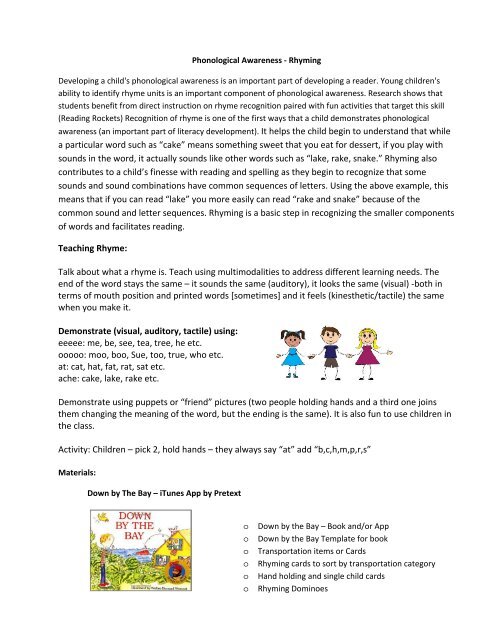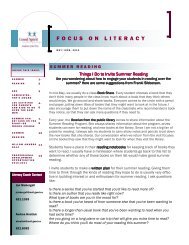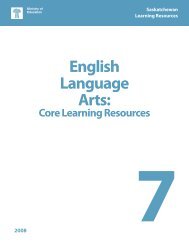Phonological Awareness â Rhyming Lesson Plan - GSSD Blogs
Phonological Awareness â Rhyming Lesson Plan - GSSD Blogs
Phonological Awareness â Rhyming Lesson Plan - GSSD Blogs
You also want an ePaper? Increase the reach of your titles
YUMPU automatically turns print PDFs into web optimized ePapers that Google loves.
<strong>Phonological</strong> <strong>Awareness</strong> ‐ <strong>Rhyming</strong><br />
Developing a child's phonological awareness is an important part of developing a reader. Young children's<br />
ability to identify rhyme units is an important component of phonological awareness. Research shows that<br />
students benefit from direct instruction on rhyme recognition paired with fun activities that target this skill<br />
(Reading Rockets) Recognition of rhyme is one of the first ways that a child demonstrates phonological<br />
awareness (an important part of literacy development). It helps the child begin to understand that while<br />
a particular word such as “cake” means something sweet that you eat for dessert, if you play with<br />
sounds in the word, it actually sounds like other words such as “lake, rake, snake.” <strong>Rhyming</strong> also<br />
contributes to a child’s finesse with reading and spelling as they begin to recognize that some<br />
sounds and sound combinations have common sequences of letters. Using the above example, this<br />
means that if you can read “lake” you more easily can read “rake and snake” because of the<br />
common sound and letter sequences. <strong>Rhyming</strong> is a basic step in recognizing the smaller components<br />
of words and facilitates reading.<br />
Teaching Rhyme:<br />
Talk about what a rhyme is. Teach using multimodalities to address different learning needs. The<br />
end of the word stays the same – it sounds the same (auditory), it looks the same (visual) ‐both in<br />
terms of mouth position and printed words [sometimes] and it feels (kinesthetic/tactile) the same<br />
when you make it.<br />
Demonstrate (visual, auditory, tactile) using:<br />
eeeee: me, be, see, tea, tree, he etc.<br />
ooooo: moo, boo, Sue, too, true, who etc.<br />
at: cat, hat, fat, rat, sat etc.<br />
ache: cake, lake, rake etc.<br />
Demonstrate using puppets or “friend” pictures (two people holding hands and a third one joins<br />
them changing the meaning of the word, but the ending is the same). It is also fun to use children in<br />
the class.<br />
Activity: Children – pick 2, hold hands – they always say “at” add “b,c,h,m,p,r,s”<br />
Materials:<br />
Down by The Bay – iTunes App by Pretext<br />
o<br />
o<br />
o<br />
o<br />
o<br />
o<br />
Down by the Bay – Book and/or App<br />
Down by the Bay Template for book<br />
Transportation items or Cards<br />
<strong>Rhyming</strong> cards to sort by transportation category<br />
Hand holding and single child cards<br />
<strong>Rhyming</strong> Dominoes
Transportion Name Game (adapted from link: http://www.succeedtoread.com/rhyme.html)<br />
How to Play: Begin by modeling how to rhyme. Point to a vehicle, while saying a word that<br />
rhymes with it. Your child should say the real name of the vehicle. This puts rhyming into his/her<br />
ears with a visual cue (pointing). If you point to a car and say star, he/she will automatically say<br />
car.<br />
1. Tell your child, "We are going to play a rhyming game. <strong>Rhyming</strong> words have the same<br />
sound endings. I'm going to point to one of these vehicles. You're going to say the word<br />
that rhymes with what I say that tell us the real name of the vehicle. Okay?"<br />
2. Give him/her two examples: "I'm pointing to a train, and I say crane. You say train. I'm<br />
pointing a boat. I say coat, and you say boat.<br />
Here are some examples:<br />
boat – coat van – man bike – Mike<br />
train – rain<br />
car – star<br />
jet – pet<br />
ship – chip<br />
<br />
Time to Sing/Chant – Down By the Bay (Raffi version or iTunes app by Pretext)<br />
<br />
<br />
Encourage participation in the song<br />
Emphasize /s/ sounds as you encounter them. Use visual hand sign<br />
as you say the /s/ in words and encourage the children to use it<br />
too (if you have an additional adult or student volunteer available).<br />
<br />
Book Sharing – Down By the Bay by Raffi; illustrated by Nadine Westcott<br />
o Encourage participation in the book<br />
o Emphasize the rhyme as you encounter them<br />
o Probe for recognition of the rhymes. Read a sentence and ask them to fill in the missing<br />
rhyming word.<br />
Class Activity:<br />
<br />
<br />
Sorting Rhymes:<br />
o Each student is given a picture card illustrating a word that rhymes with one of the<br />
transportation items. Each card is going on a trip but can only get there via the mode<br />
of transportation that rhymes with them (e.g. the “coat” cannot travel in the ship,<br />
train or jet; it must travel in the “boat”)<br />
o The class is given time to card in the right mode of transportation (the one that<br />
rhymes with it)<br />
Down by the Bay Book – Stations are set up near the transportation object (e.g. “ship”). A book page<br />
template of “Down by the Bay” is placed there with a picture of a ship and various pictures that<br />
rhyme with ship. The student then cuts out and glues on appropriate pictures to make a rhyme (e.g.<br />
“Did you ever see a “lip” sailing in a “ship?” Down by the bay.” They can go to as many stations as<br />
there is time for. To increase the difficulty of this task, you may wish to include “foils” which do not<br />
rhyme.
Environment/Extension Activities:<br />
<strong>Rhyming</strong><br />
<br />
<br />
Picture Sorts and Matching<br />
o Use pictures to reinforce rhyming words. Have children match rhyming words<br />
Songs, Books, Nursery Rhymes<br />
o Read poetry, nursery rhymes, and explore songs that rhyme. Emphasize rhyming words<br />
will reading and singing.<br />
o Pause before a rhyming word to allow your student to fill in the missing word.<br />
o Silly reading day: create your own activity using a book. Using a familiar story, change<br />
words within the story to a word that rhymes with the target word (e.g. “Once upon a time<br />
there were three “pears.”)<br />
<br />
<br />
<br />
<br />
<br />
<br />
<strong>Rhyming</strong> Bingo<br />
o Students must match pictures on their bingo card that rhyme with the word the bingo<br />
caller calls out<br />
Art<br />
o Make rhyming chains; or write rhyming words on construction paper and build a house for<br />
the rhyming family to live in; make a rhyme collage<br />
Fishing<br />
o Attach magnets to picture cards, and attach a magnet to a string on the end of a pole. Fish<br />
for rhymes, or produce rhymes to match the card you pull.<br />
One of these Words Doesn’t Belong<br />
o Have a series of four pictures, three of which rhyme and one which does not (word families<br />
lend themselves to this activity if you take the “word” away). Have the student select which<br />
word does not belong. It is generally easier if the first word is one that belongs in the rhyming<br />
family.<br />
I Spy a <strong>Rhyming</strong> Word<br />
o Play a game of I Spy, where your students find something in the classroom that rhymes with<br />
a word they are given. Some of the words you provide will be nonsense words, but the<br />
word/item they are looking for must be a real word. Don’t forget to use some of the<br />
students’ names.<br />
Super Duper Fun Deck: <strong>Rhyming</strong> Words in Sentences<br />
Websites:<br />
<strong>Rhyming</strong>:<br />
http://www.readingrockets.org/strategies/rhyming_games/<br />
http://teams.lacoe.edu/documentation/classrooms/patti/k‐1/activities/rhyming.html<br />
http://phonologicalawareness.org/4.html
















